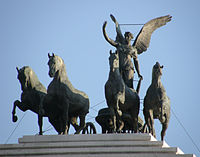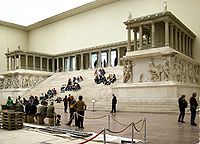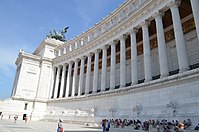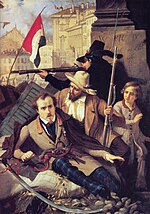Victor Emmanuel II Monument
| Victor Emmanuel II National Monument | |
|---|---|
Monumento Nazionale a Vittorio Emanuele II | |
 View from Piazza Venezia | |
 Click on the map for a fullscreen view | |
| Alternative names | "Mole del Vittoriano" "Il Vittoriano" "Altare della Patria" |
| General information | |
| Type | National monument |
| Architectural style | Neoclassicalwitheclecticinfluences |
| Location | Rome,Italy |
| Address | Piazza Venezia |
| Coordinates | 41°53′41″N12°28′59″E/ 41.89472°N 12.48306°E |
| Construction started | 1885 |
| Completed | 1935 |
| Inaugurated | 4 June 1911 |
| Owner | Ministry of Cultural Heritage and Activities |
| Height | 81 m (266 ft) |
| Dimensions | |
| Other dimensions | 135 m (443 ft) across x 130 m (427 ft) deep |
| Technical details | |
| Floor area | 717,000 m2(7,717,724 sq ft) |
| Lifts/elevators | 1 |
| Grounds | 1.755 ha (4.34 acres) |
| Design and construction | |
| Architect(s) | Giuseppe Sacconi[1] |
TheVictor Emmanuel II National Monument(Italian:Monumento Nazionale a Vittorio Emanuele II), also known as theVittorianoorAltare della Patria( "Altar of the Fatherland" ), is a largenational monumentbuilt between 1885 and 1935 to honourVictor Emmanuel II,the first king of aunified Italy,inRome,Italy.[2]It occupies a site between thePiazza Veneziaand theCapitoline Hill.The monument was realized byGiuseppe Sacconi.
From an architectural perspective, it was conceived as a modernforum,anagoraon three levels connected by stairways and dominated by aporticocharacterized by acolonnade.The complex process of national unity and liberation from foreign domination carried out by King Victor Emmanuel II of Savoy, to whom the monument is dedicated, has a great symbolic and representative value, being architecturally and artistically centred on theunification of Italy—for this reason the Vittoriano is considered one of thenational symbols of Italy.
It also preserves the Altar of the Fatherland (Italian:Altare della Patria), first analtarof thegoddess Roma,then also ashrineof theItalian Unknown Soldier,thus adopting the function of aseculartemple consecrated to Italy. Because of its great representative value, the entire Vittoriano is often called the Altare della Patria, although the latter constitutes only a part of the monument.
It is currently managed by thePolo Museale del Lazioand is owned by theMinistry of Cultural Heritage and Activities.
General description
[edit]
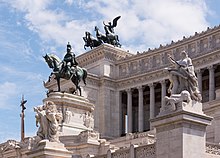
The Vittoriano is on theCapitoline Hill,in the symbolic centre ofancient Rome,and is connected to the modern one thanks to roads that radiate fromPiazza Venezia.[3]
Its design is aneoclassicalinterpretation of theRoman Forum.It features stairways,Corinthian columns,fountains, anequestrian sculptureof Victor Emmanuel II, and two statues of the goddessVictoriariding onquadrigas.On its summit is a majesticporticocharacterized by a long colonnade and two imposingpropylaea,one dedicated to the "unity of thehomeland",and the other to the" freedom of the citizens ", conceptsmetaphoricallylinked to the figure of Victor Emmanuel II.[3]
The base houses the museum ofItalian unification,[4][5]and in 2007 a lift was added to the structure, allowing visitors to access the roof for 360-degree views of Rome.[6]This terrace, which is the highest of the monument, can also be reached via 196 steps that start from the portico.[7]
The structure is 135 m (443 ft) wide, 130 m (427 ft) deep, and 70 m (230 ft) high.[3][8]If the quadrigae andWingedVictorysare included, the height reaches 81 m (266 ft).[4]It has a total area of 17,550 m2(188,907 sq ft) and possesses, due to the conspicuous development of the interior spaces, a floor area of 717,000 m2(7,717,724 sq ft).[3][8]
One of the architecturally predominant elements of the Vittoriano are the external staircases, which constitute in the complex 243 steps, and the portico on the top of the monument, which is inserted between two lateral propylaea.[3]The entrance stairway is 41 m (135 ft) wide and 34 m (112 ft) long, the terrace of theAltarof theFatherlandis 66 m (217 ft) wide.[8]The maximum depth of the Vittoriano underground reaches 17 m (56 ft) below street level. Thecolonnadeis formed by columns 15 m (49 ft) high and the length of the porch is 72 m (236 ft).[3]
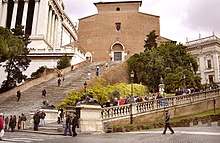
Theallegoriesof the monument mostly represent the virtues and feelings, very often rendered aspersonifications,also according to the canons of the neoclassical style, which animate the Italians during theItalian unification,or from therevolutions of 1820to thecapture of Rome(1870), through which national unity was achieved.[9]Due to the complex process of unification undertaken by Victor Emmanuel II throughout the second half of the 19th century, the Italians gave him the epithet ofFather of the Fatherland(Italian:Padre della Patria). The only non-allegoricalwork is the equestrian statue of Victor Emmanuel II,[3]which is the architectural centre of the Vittoriano.[8]

The monument, as a whole, appears as a sort of marble covering on the northern slope of theCapitoline Hill:[3]it was therefore thought of as a place where it is possible to make an uninterrupted patriotic walk (the path does not in fact have an architectural end, given that the entrances to the highest part are two, one for each propylaeum) among the works present, which almost all have allegorical meanings linked to thehistory of Italy.[8]Different are the vegetal symbols present, among which thepalm,which recalls the "victory", theoak(the "strength" ), thelaurel(the "victorious peace" ), themyrtle(the "sacrifice" ) and theOlivetree (the "concord" ).[10]
From a stylistic perspective, the architecture and works of art that embellish the Vittoriano have been conceived with the aim of creating a "national style" to be replicated in other areas.[11]It was designed to communicate the imperialsplendours of ancient Rome.[12]Above all, for the realization of the Vittoriano, Giuseppe Sacconi took inspiration from theNeoclassical architecture—the reborn heir of theclassical GreekandRoman architecture,on whichItalic elementswere grafted andeclectic influencesadded.[8]
The Vittoriano is regarded as anational symbol of Italyand every year it hosts important national celebrations.[2]The largest annual celebrations areLiberation Day(25 April),Republic Day(2 June), andArmed Forces Day(4 November). During these celebrations, thePresident of the Italian Republicand the highest government officials pay tribute to theItalian Unknown Soldierand those who died in the line of duty by laying alaurel wreath.[8]
History
[edit]| Part ofa serieson the |
| Culture of Italy |
|---|
 |
| People |
| Traditions |
After the death ofVictor Emmanuel II of Savoyon 9 January 1878, many initiatives were destined to raise a permanent monument that celebrated the firstking of a united Italy,creator of the process ofunification and liberationfrom foreign domination, which is indicated by historiography as "Father of the Fatherland"also due to the political work of thePresident of the Council of Ministers of the Kingdom of SardiniaCamillo Benso, Count of Cavour,and to the military contribution ofGiuseppe Garibaldi.The goal was therefore to commemorate the entireItalian unificationseason ( "Risorgimento" ) through one of its protagonists.[10][9]
For this purpose, the Italian government approved the construction of a monumental complex on the Northern side ofRome'sCapitoline Hill.The monument would celebrate the legacy of the first king of a united Italy and would become a symbol of national patriotism. The project was realized byGiuseppe Sacconiin 1885, in aneclecticstyle.[8][1]
Sacconi was inspired by theHellenistic sanctuaries,such as thePergamon Altarand theSanctuary of Fortuna PrimigeniainPalestrina.[8]The Vittoriano was conceived as a vast and modernforum[9]open to citizens, on a sort of elevated square in the historic centre of Rome organized as anagoraon three levels connected by tiers, with conspicuous spaces reserved for strolling visitors.[3][12]
To erect the Vittoriano it was necessary, between the last months of 1884 and 1899,[3]to proceed with numerous expropriations and extensive demolitions of the buildings that were on the site.[3]The place chosen was in the heart of the historic centre of Rome and was therefore occupied by ancient buildings arranged according to urban planning that dated back to theMiddle Ages.[13]This was considered necessary because the Vittoriano should have been built in the heart of the historic centre of Rome, in a modern urban context, in front of a new large square (the futurePiazza Venezia), which at the time was just a narrow open space in front ofPalazzo Venezia.[14]
The general objective was also to make Rome a modern European capital that rivaledBerlin,Vienna, London and Paris[12]overcoming the centuries-old pontifical town planning.[12]In this context, the Vittoriano would have been the equivalent of theBrandenburg Gateof Berlin, theAdmiralty Archof London and theOpéra Garnierof Paris; these buildings are all united by a monumental and classical aspect thatmetaphoricallycommunicates pride and the power of the nation that erected them.[12]
It would then become one of the symbols of the new Italy, joining the monuments ofancient Romeand those of thepopes' Rome.[8][10]Having then been conceived as a large public square, the Vittoriano, in addition to representing a memorial dedicated to Victor Emmanuel II, was invested with another role—a modernforumdedicated to the new free and united Italy.[15]
Established Italian sculptors, such asLeonardo Bistolfi,Manfredo Manfredi,Giulio Monteverde,Francesco Jerace,Augusto Rivalta,Lodovico Pogliaghi,Pietro Canonica,Ettore Ximenes,Adolfo Apolloni,Mario RutelliandAngelo Zanelli,made its sculptures nationwide.[16]The partly completed monument was inaugurated on 4 June 1911, on the occasion of theTurin Internationalworld's fair and the 50th anniversary ofItalian unification.Construction continued throughout the first half of the 20th century; in 1921 thebody of the Italian Unknown Soldierwas placed in the crypt under the statue of the goddess Roma, and in 1935 the monument was fully completed amidst the inauguration of the Museo Centrale del Risorgimento Italiano.[4]
The decision to include analtardedicated to the homeland in the Vittoriano was taken by Giuseppe Sacconi only after the planning phase, during the construction of the monument.[8]The place and the dominant subject were immediately chosen, being a large statue of thegoddess Romathat would have been placed on the first terrace after the entrance to the monument, just below the equestrian statue of Victor Emmanuel II.[8]Thus, the Altar of the Fatherland, at least initially and before the burial of the body of the Unknown Soldier, was thought of as a chapel of the deity.[3]In this way, the greatness and majesty of Rome was celebrated, elected to the role of legitimate capital of Italy.[13]Within the Vittoriano are numerous artistic works that recall the history ofancient Rome.[12]
After theFirst World Warthe Vittoriano was chosen to house the tomb of the Unknown Soldier, or the burial of an Italian soldier who died during the First World War whose identity remains unknown due to the serious injuries that made the body unrecognizable, which represents all the Italian soldiers who died during the wars.[17]The reason for his strongsymbolismlies in themetaphoricaltransition from the figure of the soldier to that of the people and finally to that of the nation. This transition between increasingly broader and generic concepts is due to the indistinct traits of the non-identification of the soldier.[8]
The Vittoriano was thus consecrated to a wide symbolic value representing alaytemplemetaphoricallydedicated to a free and united Italy—celebrating by virtue the burial of the Unknown Soldier (the sacrifice for thehomelandand for the connected ideals).[11][9][8]
With the rise ofFascismin 1922, the Vittoriano became the setting for the military parades of theauthoritarian regimeofBenito Mussolini.AfterWorld War II,with the institution of theItalian Republicin 1946, the monument was stripped of all its Fascist symbols and reassumed its original function as a secular temple dedicated to the Italian nation and its people.[8]Throughout the second half of the 20th century, however, its significance as a symbol ofnational identitystarted to decline as the public opinion started to perceive it as a cumbersome relic.[2]At the turn of the 21st century, Italy's PresidentCarlo Azeglio Ciampipushed for a revaluation ofnational symbols of Italy,including the Vittoriano.[3]
-
The façade of the Pergamon Altar inspired Giuseppe Sacconi for the general project of the Vittoriano
-
The demolition area on a map from 1870 where the Vittoriano and the future Piazza Venezia are marked in black
-
Piazza Venezia as seen from the Vittoriano terraces
-
Detail of the portico and one of the two propylaea
Tomb of the Unknown Soldier
[edit]
The monument holds theTomb of the Italian Unknown Soldierwith aneternal flame,built under the statue of goddessRomaafterWorld War Ifollowing an idea of GeneralGiulio Douhet.[17]The body of the unknown soldier was chosen on 28 October 1921 from among 11 unknown remains byMaria Bergamas,a woman fromGradisca d'Isonzowhose only child was killed duringWorld War I.[17]Her son's body was never recovered. The selected unknown was transferred fromAquileia,where the ceremony with Bergamas had taken place, to Rome and buried in a state funeral on 4 November 1921.[17]
His tomb is a symbolicshrinethat represents all the fallen and missing of the war.[10]The side of the tomb of the Unknown Soldier that gives outward at the Altar of the Fatherland is always guarded by a guard of honour and two flames that burn perpetually in braziers.[18]The guard is provided with military personnel of the various weapons of theItalian Armed Forces,which alternate every ten years.[17]
Theallegoricalmeaning of the perpetually burning flames is linked to their symbolism, which is centuries old, since it has its origins inclassical antiquity,especially in thecult of the dead.A fire that burns eternally symbolizes the memory, in this case of the sacrifice of the Unknown Soldier moved by patriotic love, and his everlasting memory of the Italians, even in those who are far from their country. The two perennial braziers next to the Tomb of the Unknown Soldier is placed a plaque whose text reads "Italians Abroad to theMotherland"in memory of donations made byItalian emigrantsbetween the end of the 19th century and the beginning of the 20th century for the construction of the Vittoriano.[19]
Names
[edit]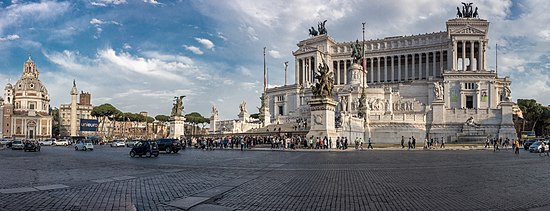
The Victor Emmanuel II National Monument is also known as "Mole del Vittoriano" or simply the "Vittoriano", and "Altare della Patria", which are now the most commonly used names for it.[8]From 1921, when the Unknown Soldier was buried under the statue of the goddess Roma in the part of the Vittoriano that is called "Altare della Patria", the expression began to indicate not only the place of burial of the soldier, or the personification of all the fallen and lost in war, but the whole structure due to the strong popular sentiment for the symbolic Unknown Soldier.[8]
Colloquially, the monument is also known as "The Wedding Cake" or "The Typewriter".[20]
Plan
[edit]
|
Architectural and artistic works
[edit]Fountains of the two seas
[edit]
Set against the external base of the Vittoriano, on the sides of the entrance to Piazza Venezia, are the "fountains of the two seas" which are dedicated to theAdriatic Seaand theTyrrhenian Sea.Both are inserted in a flower bed and possess, from the beginning, a hydraulic system that recycles the water avoiding waste. Historically, a 500,000 litres (130,000 US gal) water cistern was also active, then abandoned, in the basement of the monument.[3]The two fountains therefore represent the two major Italian seas and, therefore, in this perspective the Vittoriano is assimilated to theItalian Peninsula.This way the whole country is represented, even geographically.[11]
External staircases and terraces
[edit]
The exterior staircases of the Vittoriano follow the ascending sides of the northern slope of theCapitoline Hilland lead, starting from the entrance ofPiazza Venezia,to the terrace of theAltarof theFatherland,then to the terrace of theredeemedcities (the one immediately below thecolonnadeof theportico), and finally to the terraces of the twopropylaeaflanked by the portico constituting the two entrances.[12][3][8]
At the entrance is a staircase leading to the terrace of the Altar of the Fatherland and of theItalian Unknown Soldier,which represent the first raised platform of the Vittoriano, as well as its symbolic centre.[8]The path along the staircase continues beyond the tomb of the Unknown Soldier to symbolically represent a continuous and uninterrupted procession of Italians, continuing up to the highest point of the construction, the portico and the propylaea.[11]
The artisticgateof access to the Vittoriano, which is the work ofManfredo Manfredi,is able to slide vertically underground on tracks. The plant that allows the lowering of the railing, originally hydraulic, was considered at the time of its construction among the most technologically advanced in the world. The entrance gate has a length of 40 m (131 ft) and a weight of 10,500 tons.[3]
On both sides of the entrance stairway are a series of sculptures that accompany the visitor towards the Altar of the Fatherland.[8]The first sculptures are two groups in gildedbronze,[10]with subjects inspired by the thought ofGiuseppe Mazzini,[11]The ThoughtandThe Action(respectively, to the left and right of the staircase for those coming from Piazza Venezia), followed by two sculptural groups (also in this case one on each side) depicting as manyWinged lionsand finally, on the top of the staircase, before the beginning of the terrace of the Altar of the Fatherland, twoWinged Victorys.[8]The Actionhas a triangular and angular profile, whileThe Thoughthas a circular shape.[21]TheWinged Victories,in addition to recalling the military and cultural successes of theRoman era,symbolizeallegoricallythegood luckof national unity.[21]

At the end of the entrance stairway, immediately after the statues of theWinged Victories,opens the terrace of the Altar of the Fatherland, the first raised platform of the Vittoriano, which is dominated centrally by the statue of thegoddess Romaand the shrine of the Unknown Soldier.[8]On the terrace of the Altar of the Fatherland are also theBotticino marblesculptural groups that symbolize the moral values of the Italians, or the ideal principles that make the nation firm.[10]The four groups have a height of 6 m (20 ft) and are to the right and left of the entrance to the terrace of the Altar of the Fatherland (two on each side), sideways to the statues ofThe Thoughtand ofThe Actionand in correspondence of the fountains of two seas, along the parapets that overlook Piazza Venezia.[8]The concepts expressed by these four sculptural groups,The Force,The Concord,The SacrificeandThe Right,are the tangible emanation ofThe ThoughtandThe Action.[21]

At the sides of the Altar of the Fatherland, the staircase resumes dividing into two symmetrical ramps parallel to the tomb of the Unknown Soldier.[22]Both reach a pronaos where two large doors open (one on each side, both positioned symmetrically and laterally to the Unknown Soldier, and each in correspondence with one of the two propylaea) that lead to the interior spaces of the Vittoriano. Above each door are two statues; on the left door areThe PoliticsandThe Philosophy,while on the right door are two statues depictingThe WarandThe Revolution.[8]
From the two shelves where the doors open to give access to the interior spaces, two further flights of stairs start that converge, directly behind the Altar of the Fatherland, towards the base of the equestrian statue of Victor Emmanuel II – the latter is on the second large elevated platform, in order of height, of the Vittoriano.[8]Behind it, the stairway resumes its ascent in the direction of the portico, reaching a small shelf, from which two staircases start laterally leading to the entrance of a propylaeum. Before reaching the entrances of the propylaea, each of the two staircases is interrupted, creating a small intermediate shelf, which allows access to the terrace of the redeemed cities—the third large and last elevated platform of the Vittoriano—directly behind the equestrian statue of Victor Emmanuel II and immediately below the colonnade of the portico.[22]
The redeemed cities are those united to Italy following theTreaty of Rapallo (1920)and theTreaty of Rome (1924),peace agreements at the end of theFirst World War.These municipalities areTrieste,Trento,Gorizia,Pola,FiumeandZara.[8]Following theParis treaties of 1947,Pola, Fiume and Zaramoved on to Yugoslaviaand, after thedissolution of the latter,toCroatia.After the conflict, Gorizia was divided into two parts—one part remained in Italy while the other, which was renamed "Nova Gorica",passed first toYugoslaviaand then toSlovenia.[23]Each redeemed city is represented by an altar against the back wall, which bears the corresponding municipal coat of arms.[11][8]The six altars were placed on the terrace between 1929 and 1930.[8]

At the centre of the row of altars of the redeemed cities, engraved on thestylobate,is a monumental inscription carved on the occasion of the solemn ceremony of the Unknown Soldier (4 November 1921) which contains the text of theVictory Bulletin,an official document written after theArmistice of Villa Giustiwith which the generalArmando Diaz,supreme commander of the Royal Army,announced, on 4 November 1918, the surrender of theAustro-HungarianEmpire and the victory of Italy in the First World War.[8]
At the base of the text of the Victory Bulletin are two other altars similar to those of the redeemed cities but which have, instead of the municipal coat of arms of the municipalities, ahelmet—these two altars bear the inscription "Et Facere Fortia"on the left alter and"Et Pati Fortia"on the right alter. They echo theLatin phraseet facere et pati fortia Romanum est( "It is the attribute of a Roman to perform as well as to suffer mighty things" ) written byLivyin theHistory of Rome,book 11; in the work the phrase is pronounced byScaevolatowardsLars Porsena.[8]
Altar of the Fatherland
[edit]

TheAltarof theFatherlandis the most famous part of the Vittoriano and is the one with which it is often identified.[8]On the top of the entrance stairway, it was designed by theBresciansculptorAngelo Zanelli,who won a competition specially held in 1906.[10][8]It is formed from the side of theTomb of Italian Unknown Soldierthat faces the outside of the building (the other side, which faces inside the Vittoriano, is in a crypt), from thesacellumof the statue of thegoddess Roma(which is exactly above the tomb of the Unknown Soldier) and two vertical marblereliefsthat descend from the edges of theaediculacontaining the statue of the goddess Roma and which run downwards laterally to the tomb of the Unknown Soldier.[10]
The statue of the goddess Roma present at the Vittoriano interrupted a custom in vogue until the 19th century, by which the representation of this subject was with exclusively warlike traits. Angelo Zanelli, in his work, decided to further characterize the statue by also providing the reference toAthena,Greek goddessofwisdomand the arts, as well as of war.[21]The great statue of the deity emerges from a golden background.[8]The presence of the goddess Roma in the Vittoriano underlines the irremissible will of theUnification of Italypatriots to have the Rome as the capital of Italy, an essential concept, according to the common feeling, from the history of the peninsula and the islands ofItalian culture.[11][12]
The general conception of the bas-reliefs, beside the statue of the goddess Roma, one to her left and the other to her right, recallsVirgil'sBucolicsandGeorgics,which complete thetriptychof the Altar of the Fatherland with the statue of the Roman divinity.[8]
Theallegoricalmeaning of the bas-reliefs that are inspired by the works of Virgil is linked to the desire to conceptually render the Italian soul.[24]In theGeorgics,the reference to theAeneidis in fact present, and in both the works the industriousness in the work of the Italians is recalled.[11][24]
The bas-relief on the left of the Altar of the Fatherland represents theTriumph of Labourand the one on the right symbolizes theTriumph of the Patriotic Lovewhere both converge scenically towards the statue of the goddess Roma.[11][10][13]
Equestrian statue of Victor Emmanuel II
[edit]
After the Altar of the Fatherland is the equestrian statue of Victor Emmanuel II, a bronze work by Enrico Chiaradia and architectural centre of the Vittoriano.[8]The personifications of the nobleItalian citiesare carved on the marble base of the statue.[11]The statue is bronze, 12 m (39 ft) high, 10 m (33 ft) long, and weighs 50 tons.[8]Including the marble base, the entire sculptural group is 24.80 m (81 ft) high.[8]
The equestrian statue ofVictor Emmanuel IIis the only non-symbolic representation of the Vittoriano, given that it is the representation of the homonymous monarch.[10]Inclassical antiquitythe equestrian statues were aimed at the exaltation of the portrayed subject, whose warlike virtues were emphasized. Furthermore, riding and controlling a steed, the character's ability to control primordial instincts was communicated—in this way, the subject was also recognized ascivic virtues.[25]
The statue being at the architectural centre of the Vittoriano, above the Altar of the Fatherland and in front of thecolonnadeof theportico,is not fortuitous – in classical antiquity such equestrian statues were often in front of colonnades, public squares, temples or along the triumphal streets; in places, therefore, stressing centrality. The presence of the basement on which the personifications of the noble cities are carved is linked to the same archaic traditions.[25]
Statues of noble cities
[edit]On the base of the equestrian statue of Victor Emmanuel II are sculptural depictions of 14Italian noble cities,or rather the capitals ofItalian statesfounded before theSavoy monarchy.[26]
They are not the statues of the most important cities in Italy, but of those that were once capitals ofancient Italian pre-unification monarchies,all of which are precedent and therefore historically converging towards the Savoy monarchy—for this reason they are considered "mothers noble" s of Unification of Italy.[26]
The 14 sculptural representations of the noble cities are deliberately placed at the base of the equestrian statue of Victor Emmanuel II, whichmetaphoricallysymbolizes the nature of historical foundations of Italy. In a broader sense, they also represent the concept that the unity of the homeland, as a whole, rests on a basis constituted by the municipalities.[27]Unlike those dedicated to theregions of Italy,the statues depicting the 14 cities are all the work of the same sculptor, Eugenio Maccagnani.[10]
Portico and propylaea
[edit]
Continuing to climb the stairway beyond the equestrian statue of Victor Emmnauel II, is the most imposing and striking architectonic element—the largeporticowithCorinthian-stylecolumns, slightly curved, on the top of the monument, and inserted between two templepropylaeacalled "sommoportico" due to its elevated position.[28]The propylaea are the two small porticos projecting from the portico, at its lateral (side) ends, that constitute the entrances.[3]
The portico is 72 m (236 ft) long[8]and is centrally supported by 16 15 m (49 ft) tall columns surmounted by Corinthiancapitals,embellished by the face of theItalia turrita(at centre) andacanthusleaves.[8]The cornice above the colonnade is instead decorated with statues representing the 16allegoricalpersonifications of theItalian regionswhere each statue corresponds to a column.[11]Giuseppe Sacconi was inspired by theTemple of Castor and Polluxin theRoman Forumnearby.[8]
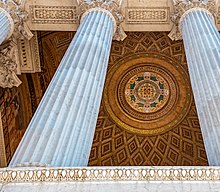
Each propylaeum has a bronze statue depictingquadrigae,each one hosting aWinged Victory.The architectural and expressive synergies of thetriumphal archesare thus re-proposed—the allegorical meaning of the "quadriga", since ancient times, is in fact that of success.[29]This concept is reinforced by the presence of theWinged Victories,messengers descended from heaven by the divinities who flank the winner of a military battle as their favourite.[30]
The two quadrigae, as the Latin inscriptions placed on thepedimentsof the underlying propylaea expressly declare, symbolize the freedom of the citizens ( "Civium Libertati",right) and the unity of the homeland ("Patriae Unitati",left), the two concepts pivots that inform the entire monument and are attributed to the sovereign Victor Emmanuel II.[10]The implicit message is that Italy, once again a single political group and gained independence, leaving behind the glories of Rome and the pomp of the papal court, is ready to spread a newItalian Renaissancearticulated on the moral virtues represented allegorically in the Vittoriano.[9]

The concepts "freedom of citizens" and "unity of the homeland" also summarize the fundamental themes[10]that characterized the beginning and the end of the contribution given by Victor Emmanuel II to theUnification of Italy.Having ascended the throne for a few months, he published the proclamation ofMoncalieri(20 November 1849) which confirmed the survival of theliberal regimeeven in the repressive period following the wave ofrevolutions of 1848.His political work had ended with thecapture of Rome(20 September 1870), which became the capital, although the unification ofTrentino-Alto AdigeandJulian March(annexed only in 1919 after the First World War) were still missing.[8]The quadrigas, already planned in the original project, were built and positioned in 1927.[10]Inside the pediments of the two propylaea are sculptural groups that have the same theme as the respective quadrigas above.[3]
The interiors of the portico and the propylaea can be accessed through two triumphal entrance stairways of each propylaeum. These are on a small shelf that can be reached via a short staircase that joins the terrace of the redeemed cities.[22]At the base of the entrance stairway of the propylaea are four statues ofWinged Victorieson triumphal columns, made in 1911 – two are at the entrance to the right propylea, and two at the entrance to the left propylea.[10]

Each entrance leads to a large quadrangularvestibule,in dialogue with the outside due to acolonnade,and from the vestibules one enters the interior spaces of the portico.[22]These rooms are decorated withmosaics,important works of floralLibertyand pictorialsymbolism,which cover thelunettesand the twodomesof the propylaea.[31]Even the mosaics have as their subject themetaphoricalrepresentation of virtues and feelings, very often rendered asallegoricalpersonifications, which animated Italians during the unification of Italy.[9]The interiors of the portico are decorated with the allegories of the sciences, while the doors that connect the propylaea and the portico are embellished with depictions on the arts.[31]
The decoration of the ceiling of the left propylaeum was entrusted to Giulio Bargellini; in thesemosaicshe adopted innovative technical devices, such as the use of materials of various kinds and tiles of different sizes and inclined so as to create studied reflections of light, and where the lines of the mosaicrepresentationscontinue towards those of the columns below.[31]The mosaics of Bargellini, along the highest part of the walls, represent figurativelyThe Faith,The Force,The WorkandThe Wisdom.[31]The decoration of the ceiling of the right propylaeum was instead entrusted to Antonio Rizzi. Rizzi dedicated himself, along the highest part of the vertical walls, toThe Law,The Value,The Peace,The UnionandThe Poetry.[31]
The internal doors leading from the two propylaea to the portico are decorated with allegorical sculptures representingThe ArchitectureandThe Music,which are found in the vestibule on the left and which are the work of Antonio Garella, andThe PaintingandThe Sculpture,in the vestibule on the right and which were made byLio Gangeri.[31]The interior of the portico has apolychromemarble floor[32]and aCofferedceiling—the latter of which was designed by Gaetano Koch, is called the "ceiling of the sciences".[31]
The ceiling owes its name to the bronze sculptures of Giuseppe Tonnini placed inside the portico, collectively known asThe AllegoriesofThe Sciences.They are all made up of female personifications:[31]The Geometry,The Chemistry,The Physics,The Mineralogy,The Mechanics,The AstronomyandThe Geography.The vertical wall opposite the columns is decorated at the top with mosaics at gilded backgrounds, after 1925. Other sculptures present inside the portico are thetrophy of arms—a vast set ofshields,cuirasses,halberds,spears,flags,arrowsandquiversin a trophy the crown of Italy is shown, along with theeaglewith thecrusader shieldand thecollar of the Annunciation(emblems of theHouse of Savoy).[32]
Statues of the regions
[edit]The staircase leading to the terrace of theredeemedcities is the best point of observation of the statues of theItalian regions,since the latter are found on the cornice of theportico,each in correspondence of a column.[33]The presence ofmetaphoricallydepicting statues of the Italian regions is inspired by theallegoricalpersonifications of theRoman provinces,often placed on commemorative monuments during theimperial era.[34]The number of statues placed on the top of the portico is equal to 16, given that at the time of the drafting of the construction project, 16 Italian regions were identified. Each statue is 5 m (16 ft) high and was entrusted to a different sculptor who were almost always native to the region of which he would have carved the image.[10]The cornice is also embellished with friezes consisting ofeaglesandlionheads.[8]
Internal crypt of the Unknown Soldier
[edit]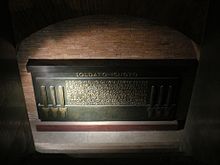
Thecryptof theItalian Unknown Soldieris under the equestrian statue of Victor Emmanuel II which can be accessed from the Shrine of the Flags museum, from where it is possible to see the side of theshrineof the Soldier that faces inwards.[8]It is thus by the Altar of the Fatherland, from where the outward side of the tomb is seen.[8]
The crypt of the Unknown Soldier is the work of the architectArmando Brasini.It is a room in the shape of aGreek crosswith adomedvault which is accessed via two flights of stairs. A short tunnel starts from the crypt and reaches the niche of the chapel of the Unknown Soldier. The niche is inserted in anarcosoliuminspired by the style of early Christian buildings, especially thecatacombs.The ceiling of the crypt instead recalls theRoman architecture,alternatingcross vaultsandbarrel vaults.[8]The room, built using bricks, is characterized by the presence of round arches and niches.[8]There is also a small altar for religious services.[8]
The walls of the crypt are decorated with a mosaic ofByzantine style,by Giulio Bargellini, of a religious nature. Thecrucifixion of Jesusis above the tomb of the Unknown Soldier, where, on the walls, stand the patron saints of theItalian Armed Forces:Saint Martinpatron of theinfantry,Saint Georgeof thecavalry,Saint Sebastianof thelocal policeandSaint Barbaraof theItalian Navy,artilleryandmilitary engineers.Finally, in the dome, is theMadonna of Loreto,patron saint of theItalian Air Force.[8]
Parts of the crypt and sepulcher were made withstone materialsfrom the mountains that were the scene of battles of theFirst World War,with the floor made ofKarstmarble, and the small altar made from a single block of stone fromMonte Grappa.[8]
Museums
[edit]Inside the Vittoriano are some museums dedicated to thehistory of Italy,especially theUnification of Italy( "Risorgimento" ): the Central Museum of the Risorgimento (Italian:Museo Centrale del Risorgimento) with an adjoining study institute, theFlag of ItalyMemorial (Italian:Sacrario delle bandiere) and an area that hosts temporary exhibitions of artistic interest, historical, sociological and cultural called "ala Brasini".[35][36]
Since 2020, together withPalazzo Venezia,it has been managed by the VIVE Institute, one of the eleven institutes of significant general interest of theItalian Ministry of Culture.[37]
Access to the Central Museum of the Risorgimento is on the left side of the monument, at the back of theSanta Maria in Ara Coelialong via di San Pietro in Carcere.[38]The period of Italian history between the end of the 18th century and theFirst World Waris displayed by memorabilia, paintings, sculptures, documents (letters, diaries and manuscripts), drawings, engravings, weapons and prints.[39][40][41]
On the entrance stairway of the Central Museum of the Risorgimento are visible engravings related to some significant episodes for the birth of the Risorgimento movement, from the seed thrown by theFrench Revolutionto theNapoleonic Wars,to better frame and remember the national history included between the reform of theancient Italian statesand the end of the First World War. Along the walls, other marble engravings show some pieces of texts enunciated by prominent personalities, which better testify and describe this part of Italian history.[39][42]
The Central Museum of the Risorgimento also includes the Shrine of the Flags, a museum where thewar flagsof dissolved military units and decommissioned ships from theItalian Army,Italian Air Force,Italian Navy,Carabinieri,Polizia di Stato,Penitentiary Police andGuardia di Finanzaare collected and temporarily stored. In case a unit is reformed, the flags are retrieved by the unit.[36]Access to the shrine is alongVia dei Fori Imperiali,where memorabilia, relating mainly to the Risorgimento wars, in which theItalian Armed Forcestook part, are also kept.[43]
The "ala Brasini", reserved for temporary exhibitions, is dedicated toArmando Brasini,the main promoter of the Central Museum. The wing has three exhibition rooms: the "large exhibition hall", with a surface area of 700 m2(7,535 sq ft), generally hosts art exhibitions, and those that require more space, the "central hall" of 400 m2(4,306 sq ft) and the "jubilee hall" of 150 m2(1,615 sq ft), are used.[44]
-
One of the two gates to thepropylaea,a gateway to the internal exhibition spaces
-
Entrance to the Central Museum of the Risorgimento from via di San Pietro in Carcere
References
[edit]- ^abEnciclopedia Treccani,VittorianoArchived6 October 2019 at theWayback Machine.
- ^abcAtkinson, David; Cosgrove, Denis (March 1998). "Urban Rhetoric and Embodied Identities: City, Nation, and Empire at the Vittorio Emanuele II Monument in Rome, 1870–1945".Annals of the Association of American Geographers.88(1): 28–49.doi:10.1111/1467-8306.00083.
- ^abcdefghijklmnopqrMaria Rosaria Coppola, Adriano Morabito e Marco Placidi,Il Vittoriano nascosto,Ministero per i beni e le attività culturali, 2005,ISBN978-88-240-1418-2.
- ^abcVidotto, Vittorio."The Invention of Two Capital Cities. Archaeology and Public Spaces in Athens and Rome"(PDF).European Association for Urban History. Archived fromthe original(PDF)on 21 February 2007.Retrieved26 February2007.
- ^d'Aquino, Niccolò (February 2001). "Capitals: Rome".Europe(403): 36–38.
- ^"Vittoriano, su con l'ascensore da oggi le terrazze con vista".Archived fromthe originalon 2 September 2021.Retrieved24 May2010.
- ^"Panorama mozzafiato dalle terrazze del Vittoriano"(in Italian). Archived fromthe originalon 5 February 2018.Retrieved4 February2018.
- ^abcdefghijklmnopqrstuvwxyzaaabacadaeafagahaiajakalamanaoapaqarasatauavawTobia, Bruno (2011).L'altare della patria(2nd ed.). Bologna: Il mulino.ISBN978-8-81523-341-7.OCLC742504798.
- ^abcdefPrimo Levi,Il monumento dell'Unità Italiana,inLa Lettura(Corriere della Sera), volume IV, april 1904.
- ^abcdefghijklmnop"L'Altare della Patria"(in Italian). Archived fromthe originalon 1 January 2018.Retrieved1 January2018.
- ^abcdefghijk"Ministero della Difesa – Il Vittoriano".www.difesa.it(in Italian).Archivedfrom the original on 14 July 2014.Retrieved14 November2018.
- ^abcdefghJohn Agnew,The Impossible Capital: Monumental Rome under Liberal and Fascist Regimes,1870–1943, Wiley Blackwell, 2005
- ^abcRomano Ugolini,Cento anni del Vittoriano 1911–2011. Atti della Giornata di studi,Gangemi Editore Spa, 2011
- ^Spiro Kostof,The Third Rome 1870–1950: an Introduction
- ^"Sacconi, Giuseppe"(in Italian). Archived fromthe originalon 19 March 2018.Retrieved15 March2018.
- ^Sandra Berresford,Italian Memorial Sculpture, 1820–1940: A Legacy of Love56.
- ^abcdeMILITE IGNOTOentry(in Italian)in theEnciclopedia Treccani
- ^"Il Vittoriano e piazza Venezia"(in Italian). 20 January 2015. Archived fromthe originalon 6 June 2017.Retrieved6 June2017.
- ^"Il mito della 'lampada perenne'"(in Italian). 13 January 2010. Archived fromthe originalon 12 February 2018.Retrieved12 February2018.
- ^Shapka, Lindsay (23 June 2012)."Art or Eyesore? The Victor Emmanuel II Monument AKA 'The Wedding Cake' in Rome".The Anthrotorian.Archivedfrom the original on 24 May 2021.Retrieved24 May2021.
- ^abcdRoberto Quarta,Roma massonica,Edizioni Mediterranee, 2009,ISBN978-88-272-2498-4.
- ^abcd"Monumento Nazionale a Vittorio Emanuele II"(in Italian). Archived fromthe originalon 1 March 2018.Retrieved1 March2018.
- ^"Treaty of Peace with Italy – Paris, 10 February 1947".Retrieved15 March2018.
- ^ab"Il Vittoriano: la scena e le quinte"(in Italian). Archived fromthe originalon 27 February 2018.Retrieved26 February2018.
- ^ab"Monumento equestre"(in Italian). Archived fromthe originalon 28 February 2018.Retrieved20 February2018.
- ^ab"Vittoriano (Altare della Patria)"(in Italian). Archived fromthe originalon 10 November 2016.Retrieved20 February2018.
- ^"Il Vittoriano: breve guida alla comprensione dei simboli del monumento al primo re d'Italia ed all'Unità della Patria"(in Italian). Archived fromthe originalon 15 September 2017.Retrieved5 February2018.
- ^"Sómmo"(in Italian). Archived fromthe originalon 18 June 2017.Retrieved26 February2016.
- ^"Quadriga"(in Italian). Archived fromthe originalon 19 March 2018.Retrieved21 February2018.
- ^"Nike"(in Italian). Archived fromthe originalon 28 February 2018.Retrieved21 February2018.
- ^abcdefghMarco Pizzo,Il Vittoriano – guida storico-artistica,Comunicare Organizzando (su concessione del Ministero per i Beni e le Attività Culturali), 2002.
- ^abTouring Club Italiano,Guida rossa Italia centrale,1925
- ^"Cronologia del Vittoriano"(in Italian). Archived fromthe originalon 27 February 2018.Retrieved27 February2018.
- ^"Altare della Patria"(in Italian). Archived fromthe originalon 28 February 2018.Retrieved27 February2018.
- ^"Il Museo Centrale del Risorgimento al Vittoriano – Dove siamo"(in Italian). Archived fromthe originalon 12 March 2018.Retrieved12 March2018.
- ^ab"Il Sacrario delle Bandiere al Vittoriano"(in Italian). Archived fromthe originalon 9 September 2017.Retrieved12 March2018.
- ^"VIVE-Vittoriano e Palazzo Venezia".senzatitolo.net(in Italian).Retrieved1 September2024.
- ^"Il Museo Centrale del Risorgimento al Vittoriano – Dove siamo"(in Italian). Archived fromthe originalon 12 March 2018.Retrieved12 March2018.
- ^abAugusta Busico,Il tricolore: il simbolo la storia,Presidenza del Consiglio dei Ministri, Dipartimento per l'informazione e l'editoria, 2005.
- ^Gilles Pécout, Roberto Balzan,Il lungo Risorgimento: la nascita dell'Italia contemporanea (1770–1922),Mondadori, 2011.
- ^"Il Museo Centrale del Risorgimento al Vittoriano"(in Italian). Archived fromthe originalon 4 March 2016.Retrieved2 March2016.
- ^"Il Museo Centrale del Risorgimento al Vittoriano"(in Italian). Archived fromthe originalon 24 September 2015.Retrieved2 March2016.
- ^"Museo Sacrario delle Bandiere delle Forze Armate al Vittoriano"(in Italian). Archived fromthe originalon 14 March 2018.Retrieved14 March2018.
- ^"Complesso del Vittoriano – Ala Brasini"(in Italian). Archived fromthe originalon 7 September 2017.Retrieved14 April2018.
External links
[edit]| Preceded by Fontana del Tritone, Rome |
Landmarks of Rome Victor Emmanuel II Monument |
Succeeded by Tomb of the Unknown Soldier (Italy) |

